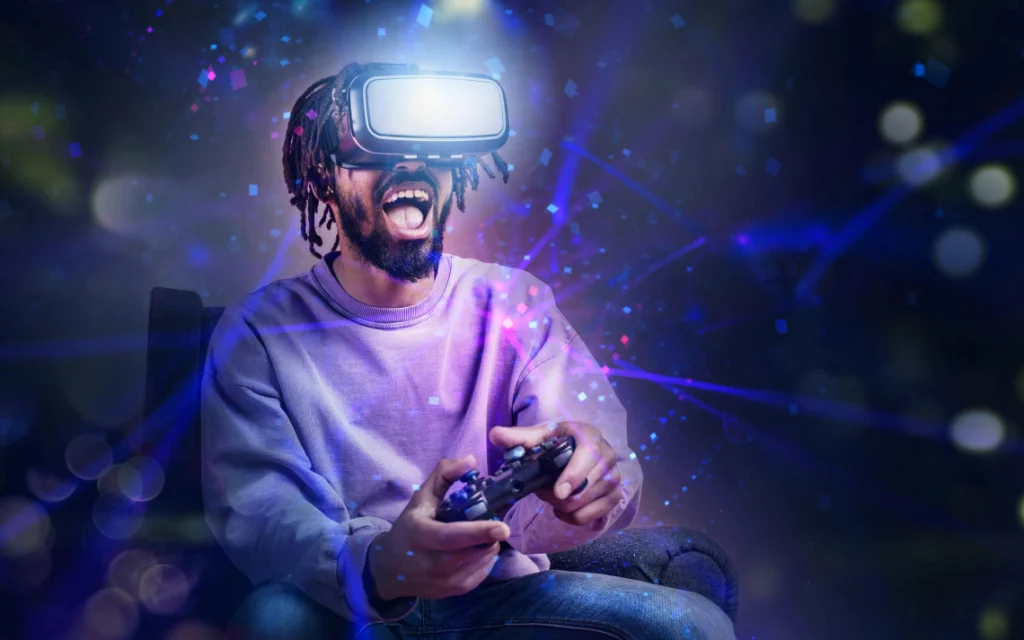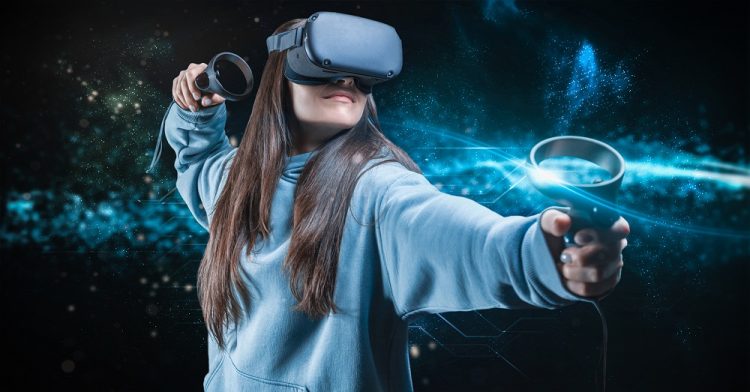Introduction: The Evolution of Entertainment Through VR & AR
The entertainment landscape has undergone a dramatic transformation in the last decade, primarily driven by advances in Virtual Reality (VR) and Augmented Reality (AR) technologies. While VR creates entirely new worlds, AR enhances our perception of the real world by overlaying digital information on top of it. Both technologies are changing the way we experience games, movies, concerts, and interactive media, offering experiences that were once the stuff of science fiction.
For gaming, entertainment, and media, VR and AR represent the cutting edge of how we interact with digital content. Whereas traditional forms of entertainment such as movies and video games primarily focused on passive observation or two-dimensional interaction, VR and AR invite users to become active participants within immersive environments.
This article explores the integration of VR and AR technologies into the gaming and entertainment industries, examining their impact on user experience, content creation, storytelling, and the future trajectory of these technologies. We will also discuss the challenges and barriers they face, as well as their potential for transforming other industries beyond gaming.
1. Understanding Virtual Reality (VR) and Augmented Reality (AR)
Before delving into how VR and AR have revolutionized gaming and entertainment, it is important to distinguish between these two immersive technologies, as they provide fundamentally different experiences.
1.1 Virtual Reality (VR)
Virtual Reality (VR) is a fully immersive digital environment where users can interact with and navigate through 3D spaces. Using specialized hardware such as headsets, motion controllers, and haptic feedback devices, VR shuts out the physical world and replaces it with a virtual experience that can be customized and controlled. The goal is to create a sense of presence, where users feel as though they are physically inside the virtual environment.
Popular VR systems like Oculus Rift, HTC Vive, and PlayStation VR have set new standards for how users can experience entertainment, including gaming, movies, and educational simulations. VR headsets are equipped with sensors that track head and hand movements, allowing users to interact with virtual objects and environments in ways that are natural and intuitive.
1.2 Augmented Reality (AR)
Augmented Reality (AR), in contrast, blends digital content with the real world. Unlike VR, AR does not replace reality but enhances it by overlaying interactive digital objects, sounds, or information on the user’s view of their environment. This can be achieved through mobile devices, smart glasses, or AR headsets. Microsoft’s HoloLens and Magic Leap are two prominent examples of AR hardware.
AR is increasingly being used in gaming and entertainment, where digital elements are superimposed on the real world. Popular mobile games like Pokémon GO have demonstrated how AR can create new forms of interaction by integrating digital characters into real-world locations. For example, players can find and catch virtual Pokémon in their neighborhood or local park, combining physical movement with virtual interactions.
2. The Impact of VR & AR on Gaming
2.1 Immersive Gameplay Experiences
One of the most significant changes VR and AR have introduced to gaming is immersion. In traditional gaming, players control characters or interact with virtual elements on a flat screen, but with VR, players are fully immersed in the world of the game. They can look around in all directions, physically move within the space, and interact with objects in a manner that mimics the real world.
For example, Beat Saber, a popular rhythm-based VR game, allows players to physically swing lightsabers to slice through blocks that appear in time with the music. This creates a highly engaging and physically interactive experience that is impossible to replicate on a traditional screen.
Advantages of Immersive VR Gaming:
- Complete immersion: Players feel as though they are actually inside the game.
- Natural interaction: Hand gestures, head movement, and body positioning can control the game.
- Enhanced emotional engagement: The heightened sense of presence leads to stronger emotional responses from players.
2.2 New Forms of Storytelling
In traditional gaming, the story is often told through linear cutscenes or scripted events. VR allows for a more dynamic and interactive form of storytelling, where players actively influence the narrative through their choices, actions, and exploration. This offers a level of immersion that was not possible in 2D gaming.
A notable example of this is Half-Life: Alyx, a VR-exclusive game that takes place in the same universe as the iconic Half-Life series. The game’s developers crafted an intricate world where players interact with the environment, solve puzzles, and engage with non-playable characters (NPCs) in a manner that feels natural and impactful. The emotional and psychological engagement in VR storytelling is significantly stronger because players are not just observing a story—they are living it.
2.3 Multiplayer and Social VR
Another exciting development is the rise of social VR, which allows users to connect, interact, and play together in virtual spaces. Games like Rec Room, VRChat, and AltspaceVR allow users to meet and engage with others in virtual environments, making VR not just a solo experience but a social one as well.
These multiplayer environments extend the concept of traditional gaming, where players typically interact through avatars or text-based chat. In social VR, players communicate through voice and body language, adding a new layer of social interaction. This creates opportunities for socializing, collaboration, and even virtual live events.
2.4 The Role of AR in Gaming
AR in gaming is focused on blending the real world with virtual elements, making the experience more interactive. Pokémon GO is the best-known example of how AR has transformed gaming by making it possible for players to find and catch Pokémon in their actual environment.
AR gaming typically relies on mobile devices or AR glasses to display digital content in real-world settings. For example, Ingress, another game developed by Niantic (the creators of Pokémon GO), uses AR to turn real-world locations into “portals” that players can interact with and control. The game blends real-world exploration with digital gameplay, encouraging players to venture outdoors and interact with their surroundings.

3. The Impact of VR & AR on Entertainment
VR and AR have expanded beyond gaming and are making significant strides in the broader entertainment sector. They are revolutionizing how we consume media, attend live events, and experience interactive storytelling.
3.1 Immersive Movies and 360-Degree Video
VR allows users to experience movies in a new way, offering 360-degree video experiences where viewers can look around in any direction and interact with the story. This type of immersive filmmaking allows users to feel like they are part of the movie, rather than merely watching it.
The Oculus TV platform and services like Within provide immersive video content that allows users to step inside virtual worlds. For instance, users can experience live-action films, animated stories, and documentaries in ways that were previously unthinkable, as the video can respond to their gaze and interactions.
3.2 Virtual Concerts and Live Performances
Artists and performers are increasingly using VR to create virtual concerts and live shows. These events are held in fully virtual environments where fans can experience live performances from the comfort of their homes. In 2020, Travis Scott held a concert in the video game Fortnite, attracting millions of players who could interact with the virtual performance. This kind of experience highlights the potential of VR in redefining entertainment events.
Similarly, platforms like Wave have created virtual concerts where fans can watch live shows, interact with virtual performers, and experience a dynamic and visually stunning experience in VR. This concept not only makes live events more accessible but also opens up new avenues for fans and artists to connect in ways that were previously impossible.
3.3 AR in Live Entertainment
AR is also becoming a tool for enhancing live performances, from concerts to theater productions. Artists can use AR to project digital elements onto real-world stages, creating visually stunning effects that interact with the live performance. For example, Theatrical productions are starting to incorporate AR to add digital effects to physical sets, enhancing the overall visual experience.
In sports, AR broadcasts allow fans to see additional data on their screens, such as player stats, scores, or team strategies, overlaid on the live action. This is becoming an increasingly common feature in both television broadcasts and live-streaming platforms.
4. Challenges in VR/AR Gaming & Entertainment
While VR and AR are undeniably transformative, they still face significant challenges that prevent them from being universally adopted in gaming and entertainment.
4.1 Hardware Limitations
VR hardware, particularly high-quality VR headsets, remains expensive and often requires a powerful PC or console to run. While mobile-based VR platforms (like Oculus Quest) have lowered the barrier to entry, the cost of a complete setup remains high, which limits widespread adoption.
AR devices such as Microsoft HoloLens and Magic Leap are still in their developmental stages and are not yet widely accessible. The technology requires powerful sensors and displays, which are difficult to miniaturize and integrate into lightweight glasses.
4.2 Motion Sickness and Comfort
VR gaming can sometimes lead to motion sickness because of discrepancies between what users see in the virtual world and their physical movements. This phenomenon, known as cybersickness, is a major barrier to prolonged VR use and remains a challenge for developers.
Both VR and AR also face concerns regarding user comfort. VR headsets can be heavy, and prolonged use can cause discomfort. Similarly, AR devices can be cumbersome and may not provide the same level of visual clarity as traditional displays.
4.3 Content Creation and Development
Creating high-quality VR and AR content requires specialized skills and tools, making development more complex and expensive compared to traditional 2D games or movies. The industry is still evolving, and there is a lack of standardized tools and frameworks for content creation. This results in a slow adoption of VR/AR across the industry, especially for smaller developers.
5. The Future of VR and AR in Gaming and Entertainment
Looking ahead, the future of VR and AR in gaming and entertainment appears to be incredibly promising. As technology continues to improve, the barriers to entry will decrease, and more people will be able to experience these immersive worlds. Additionally, the blending of VR and AR with Artificial Intelligence (AI) and 5G technology will make experiences even more dynamic and accessible.
We are likely to see even greater integration of VR/AR in daily life, from virtual tourism to digital socializing and beyond. The Metaverse, a fully immersive digital world, is gaining traction as the next evolution of the internet, offering endless possibilities for VR and AR integration.
As the hardware becomes more accessible, content creation evolves, and the technology improves, VR and AR will continue to reshape gaming and entertainment in ways that we can only begin to imagine.
Conclusion
VR and AR are far more than just technological trends; they represent a paradigm shift in how we engage with digital media. From gaming to movies, concerts, and beyond, these technologies offer opportunities for deeper immersion, interactivity, and personalization. Though challenges remain, particularly with hardware limitations and content creation, the potential of VR and AR to transform entertainment is undeniable.
As these technologies evolve, we can expect more innovations that will enhance the immersive experience, making virtual worlds an integral part of our everyday lives. The future of gaming and entertainment is exciting, with VR and AR poised to lead the charge into new and uncharted territories.











































